Out & About: Loon enthusiasts delight in Lake Fairlee’s new livestream camera
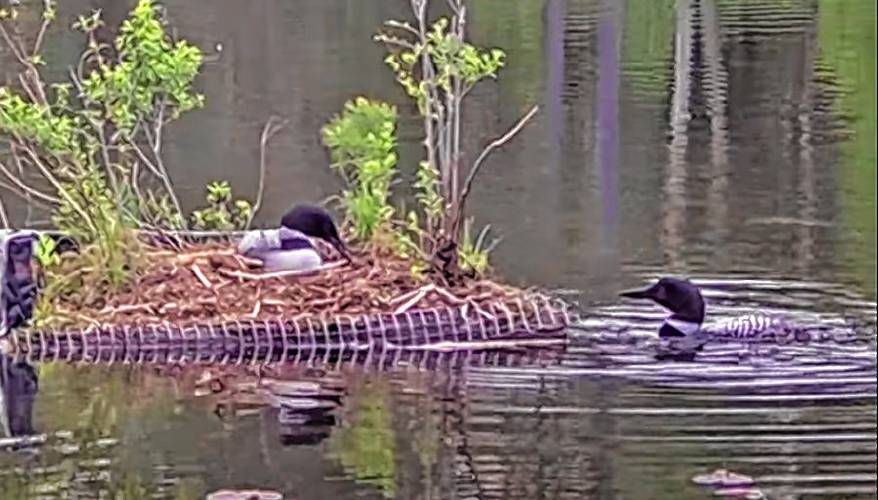
Vermont's first-ever "Loon Cam" has been installed on Lake Fairlee to follow a nesting pair through the season. (Courtesy photograph) Courtesy
| Published: 06-12-2023 4:13 PM |
FAIRLEE — A new livestream camera on Lake Fairlee is delighting loon enthusiasts and providing valuable research.
The Lake Fairlee Association debuted its LoonCam — believed to be the first in Vermont — at the start of the month. Mounted on 12-foot iron pole, the camera is about 60 feet offshore and focuses on a floating nest 40 feet away occupied by the lake’s only breeding pair of loons.
The livestream is available 24/7 on YouTube; more information and a link to the camera can be found at lakefairleevt.org. It is being managed by volunteers, with input from the Vermont Loon Conservation Project at the Vermont Center for Ecostudies and New Hampshire Loon Preservation Committee, which has two livestream loon cameras of its own.
“The footage is just revealing things in quantities and qualities that I haven’t observed before,” said Doug Tifft, the Fairlee association’s “loon ranger,” who has monitored the lake’s loons for years. “I thought I was doing good observations, but I can't see in the middle of the night. It's just reaping tremendous benefits.”
Tifft and others are eager to see if the pair will lay any eggs; last year a breeding pair had done so May 18.
“We’re very late to have laid eggs. It’s not too late, but it's very late for ours,” he said.
Eric Hanson, biologist for the Vermont Loon Conservation Project at the Vermont Center for Ecostudies, said a possible hypothesis is the territorial disputes — documented by the LoonCam — that the water birds have been having with beavers that live nearby. Earlier this year, a volunteer in southern Vermont witnessed a beaver chasing a loon from a nest. Footage from Fairlee has shown similar interactions. Beavers splash in the distance, the loons become alert and in some cases chase after them.
“Now we're having all these encounters with a beaver and they haven't laid an egg yet which makes me wonder if they're holding off,” Hanson said. “We’re wondering if the beaver is the factor,” he added, noting that it is difficult to tell if it is the same beaver, or multiple ones from the same lodge. “It'll be interesting to see, ‘do beavers and loons figure out their own territories, or is it going to be a constant bickering?’ ”
Article continues after...
Yesterday's Most Read Articles
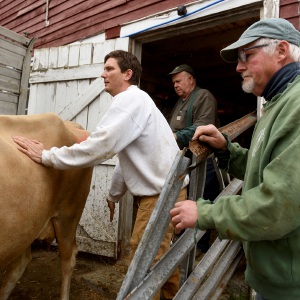 Herd departs Hartford’s last remaining dairy farm
Herd departs Hartford’s last remaining dairy farm
 Kenyon: What makes Dartmouth different?
Kenyon: What makes Dartmouth different?
 At Dartmouth, hundreds protest ongoing war in Gaza and express support for academic freedom
At Dartmouth, hundreds protest ongoing war in Gaza and express support for academic freedom
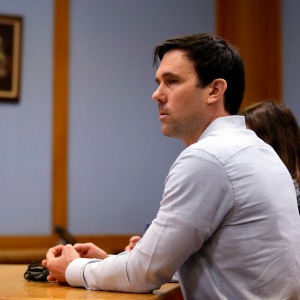 Editorial: Parker parole a reminder of how violence reshapes our lives
Editorial: Parker parole a reminder of how violence reshapes our lives
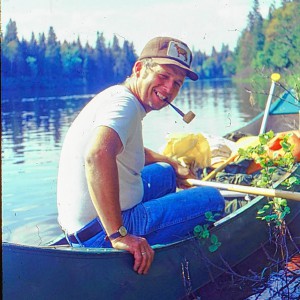 A Life: Richard Fabrizio ‘was not getting rich but was doing something that made him happy’
A Life: Richard Fabrizio ‘was not getting rich but was doing something that made him happy’
The Lake Fairlee loons nest on a floating raft that has been provided by the Vermont Center for Ecostudies for around six years, Hanson said.
“We’re going to learn that maybe we need to tweak these raft locations,” he said, if they are close to a beaver lodge.
The LoonCam cost around $1,000 and was fairly easy to set up, said Sean Brown, who chairs the association’s water quality committee. Brown, who has a background in information technology and networking, was able to hook it up to a Lake Fairlee resident’s internet connection. He can remotely manage it, including zooming in on certain scenes. The camera also backs up 12 hours of footage, which allows Brown to go back and save points of interest — like beaver encounters or when a duck family explored the nest while the loons were away.
“The stream has been incredibly stable,” Brown said.
It’s also drawn devoted and engaged followers who look at footage to let Brown know which time stamps include interesting activity.
“These people, these volunteers, these observers find and get a lot of benefit out of watching these birds in their natural habitat,” Brown said. “It’s very engrossing. It’s very easy to get sucked into watching them on the camera.”
At one point, Tifft went out in a rowboat to clear spiderwebs from the camera’s lens and the group, which has become a community, took notice. Brown jumped into the comment thread to explain what Tifft was doing and they were grateful.
“They think we're doing a great service when they're the ones doing a great service,” Tifft said. As of last Friday, they had 146 subscribers. People are watching from as far away as the UK and Switzerland, he said.
That service cannot be underestimated: Volunteers provide around 70% of the Vermont Loon Conservation Project’s data through their observations.
“For me they are my field biologists,” Hanson said. “They become the stewards of a bird that has been in trouble in the past.”
Loons can die after eating lead tackles, according to the Vermont Fish and Wildlife Department. (Both Vermont and New Hampshire have banned them.) The water birds can also be impacted by rising water levels from floods, animal predators and lakeshore development, among other factors.
That’s one of the reasons observations from volunteer loon monitors are so important.
“They become the local loon experts,” Hanson, the biologist said. That’s true on Lake Fairlee, where Tifft spends hours each day observing the loons. “Doug has done more for Lake Fairlee; for loons than I can ever do.”
This year, Hanson and a coworker at the Vermont Center for Ecostudies set up a handful of game cameras between 40 to 60 feet offshore from loon nesting sites, which will capture still images of loon activity. While he appreciates the information the livestream cameras can provide, his two-person staff does not have the capacity to set them up.
“From a time perspective, we haven't thought about it so I'm thankful (to the Lake Fairlee Association) crew, with their expertise with technology,” Hanson said, adding that if other groups are interested in setting up a livestream they should consult with the Vermont Loon Conservation Project about best practices.
The Lake Fairlee Association’s LoonCam will likely be up through the end of July. In addition to the loons, people can observe other wildlife and even watch the fog roll in over the lake.
“The people on this online community love to hear the sounds and watch the change of light,” Tifft said. “There’s som ething about this corner of Lake Fairlee that they just love.”
Liz Sauchelli can be reached at esauchelli@vnews.com or 603-727-3221.
CORRECTION: The LoonCam on Lake Fairlee is set up about 60 feet offshore. A previous version of this story included an incorrect distance for the LoonCam’s position from the shore.

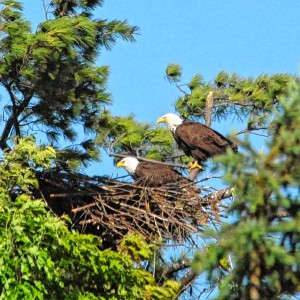 Bald eagles are back, but great blue herons paid the price
Bald eagles are back, but great blue herons paid the price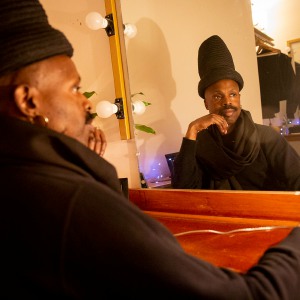 JAG Productions announces closure, citing ‘crisis facing the arts’
JAG Productions announces closure, citing ‘crisis facing the arts’
